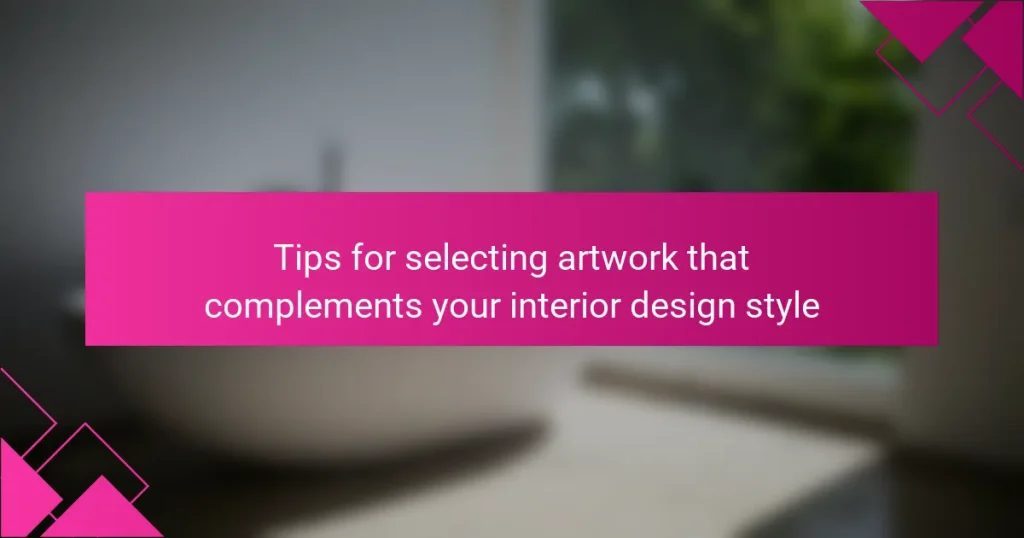Selecting artwork that complements interior design involves several key considerations, including size, color scheme, theme, personal taste, and lighting. The size of the artwork should be proportionate to the wall and surrounding furniture, with larger pieces serving as focal points and smaller pieces creating groupings. The color scheme should harmonize with the room’s existing palette, while the theme of the artwork should align with the overall design style. Personal taste plays a significant role, as individuals often choose pieces that resonate emotionally, enhancing their connection to the space. Additionally, proper lighting can greatly influence the perception of the artwork, making it an essential factor in the selection process.

What are the key considerations when selecting artwork for interior design?
Key considerations when selecting artwork for interior design include the size, color scheme, and theme of the space. The size of the artwork should be proportionate to the wall and surrounding furniture. A large piece can serve as a focal point, while smaller pieces may work better in groupings. The color scheme of the artwork should complement the existing colors in the room. This creates harmony and enhances the overall aesthetic. The theme of the artwork should align with the interior design style. For instance, abstract art may suit modern spaces, while landscapes may fit traditional styles. Additionally, personal preference plays a crucial role. Choosing pieces that resonate personally can enhance emotional connection to the space. Lastly, consider the lighting; proper illumination can significantly affect how the artwork is perceived.
How does artwork influence the overall aesthetic of a space?
Artwork significantly influences the overall aesthetic of a space. It serves as a focal point that can define the mood and style of a room. Different styles of artwork can evoke various emotions. For instance, abstract art can create a modern, dynamic feel. Traditional landscapes may bring a sense of tranquility and nostalgia. The color palette of the artwork can harmonize or contrast with existing decor. This interaction can enhance the visual appeal of the space. Additionally, the size and scale of the artwork can affect spatial perception. Larger pieces can make a bold statement, while smaller works can create intimacy. Overall, carefully selected artwork can elevate the design and character of any interior.
What role does color play in selecting artwork?
Color significantly influences the selection of artwork. It affects the mood and emotional response of viewers. Different colors evoke distinct feelings; for example, blue often conveys calmness while red can evoke passion. The color palette of the artwork should harmonize with the existing interior design. Cohesion between artwork and room colors enhances aesthetic appeal. According to a study by the Color Association of the United States, color can impact purchasing decisions in art. This indicates that color plays a crucial role in attracting potential buyers and enhancing the overall ambiance.
How can the size of artwork affect the perception of space?
The size of artwork significantly influences the perception of space. Large artwork can create a focal point, making a room feel more expansive. In contrast, small pieces may lead to a fragmented appearance, making the space feel cluttered. According to a study by the University of California, larger artworks can draw the eye upward, enhancing the perception of ceiling height. Conversely, smaller artworks may emphasize the walls, potentially making the room feel smaller. The scale of artwork should match the proportions of the room for optimal impact. Therefore, selecting appropriately sized artwork is crucial for achieving the desired spatial effect.
What styles of artwork are available for different interior design themes?
Different interior design themes feature various styles of artwork. For modern themes, abstract art and minimalistic designs are prevalent. Traditional themes often incorporate classic paintings and landscapes. Rustic designs favor nature-inspired art, such as wildlife and landscapes. Industrial themes typically showcase urban art or photography. Bohemian styles embrace eclectic and vibrant pieces, often with cultural significance. Coastal themes often include seascapes and marine life art. Art Deco designs highlight geometric patterns and bold colors. Each artwork style enhances its corresponding interior design theme by aligning with its aesthetic principles.
How do contemporary and traditional artworks differ in suitability?
Contemporary artworks are often more suitable for modern spaces, while traditional artworks fit well in classic or historical settings. Contemporary pieces frequently utilize abstract forms and bold colors. They can create a dynamic contrast in minimalist or industrial interiors. Traditional artworks typically feature realistic representations and classic themes. These artworks often evoke a sense of nostalgia and warmth. They are ideal for spaces designed with vintage or ornate furnishings. The choice between them depends on the overall aesthetic of the room and personal taste.
What types of artwork complement minimalist designs?
Artwork that complements minimalist designs includes abstract art, monochromatic pieces, and geometric designs. Abstract art often features simple forms and colors, aligning with minimalism’s emphasis on clarity. Monochromatic pieces utilize a single color palette, enhancing the serene aesthetic of minimalist spaces. Geometric designs provide structured shapes that resonate with the clean lines typical of minimalist interiors. Additionally, black and white photography can add depth without overwhelming the simplicity of the design. These types of artwork maintain the minimalist ethos while adding visual interest.

How can personal taste impact artwork selection?
Personal taste significantly influences artwork selection. Individuals often choose pieces that resonate with their emotions and experiences. This selection reflects their personality and aesthetic preferences. For instance, someone who enjoys vibrant colors may select abstract art. Conversely, a person with a preference for minimalism might opt for monochromatic pieces. Research indicates that personal taste shapes emotional responses to art. A study by the University of London found that personal connection to artwork enhances enjoyment and satisfaction. Thus, personal taste is a crucial factor in curating art that complements one’s interior design style.
What factors should be considered when incorporating personal style into artwork choices?
When incorporating personal style into artwork choices, consider the overall aesthetic of your space. The artwork should align with the interior design theme, whether it’s modern, traditional, or eclectic. Color schemes play a crucial role; choose pieces that complement or contrast effectively with existing colors. Size and scale matter; ensure the artwork fits well within the space without overwhelming it. Personal significance is important; select pieces that resonate with your experiences or emotions. Lastly, consider the framing and presentation style, as these can enhance or detract from the artwork’s impact.
How can personal experiences shape artwork preferences?
Personal experiences significantly shape artwork preferences. These experiences influence emotional connections to specific themes or styles. For instance, someone who traveled to Italy may prefer Italian landscapes. Memories tied to personal events can create a strong affinity for certain colors or subjects. Research shows that art appreciation is often linked to individual life experiences. A study published in the Journal of Arts Management, Law, and Society found that personal history impacts aesthetic preferences. This indicates that the context of one’s life plays a vital role in shaping taste in art.
What are some common pitfalls when relying solely on personal taste?
Relying solely on personal taste can lead to several common pitfalls. One significant issue is the lack of objectivity in selection. Personal preferences may overlook broader design principles. This can result in artwork that clashes with the overall decor. Additionally, personal taste may lead to repetitive choices. This can create a lack of variety and visual interest in the space. Furthermore, emotional attachment to certain pieces can cloud judgment. This may cause individuals to choose art that does not fit the intended mood or style. Lastly, ignoring current trends can make a space feel outdated. Balancing personal taste with other factors is essential for a cohesive design.
Why is it important to consider the functionality of a space when selecting artwork?
Considering the functionality of a space is crucial when selecting artwork. The artwork should enhance the purpose of the room. For example, calming pieces work well in bedrooms, while vibrant art can energize an office. Artwork can influence mood and behavior based on its visual impact. Functionality also includes the size and scale of the artwork in relation to the space. Oversized pieces can overwhelm small rooms, while small pieces may get lost in large spaces. Additionally, the style of the artwork should align with the room’s function. This alignment creates a cohesive environment that supports the intended use of the space. Therefore, selecting artwork with functionality in mind ensures it serves both aesthetic and practical purposes.
How can artwork contribute to the mood of a room?
Artwork can significantly influence the mood of a room. It serves as a visual focal point that can evoke emotions. For instance, bright colors can create a cheerful atmosphere. Conversely, darker tones may induce calmness or introspection. Different styles of artwork also convey varying feelings. Abstract pieces may inspire creativity, while landscapes can promote tranquility. The placement of artwork affects perception as well. Strategically hanging art at eye level enhances engagement. Research indicates that art impacts psychological well-being by reducing stress and improving mood. Thus, selecting the right artwork is essential for achieving the desired ambiance in a space.
What types of artwork are best suited for high-traffic areas?
Bold and vibrant artwork is best suited for high-traffic areas. This type of artwork captures attention and withstands wear. Large-scale pieces, such as murals or oversized prints, can create a focal point. Durable materials like metal or acrylic are ideal for longevity. Abstract designs often hide imperfections well, making them practical. Additionally, artwork with a clear theme can unify the space. High-contrast colors can enhance visibility in busy environments. These choices ensure that the artwork remains engaging despite constant movement around it.

What practical tips can help in selecting the right artwork?
Identify your space’s style and color palette. This ensures the artwork complements existing decor. Consider the size of the artwork in relation to the wall space. Larger pieces can make a bold statement, while smaller pieces can create a gallery effect. Think about the mood you want to evoke. Artwork can influence emotions and ambiance. Choose pieces that resonate with your personal taste and values. This connection enhances the overall enjoyment of the space. Finally, consider framing options. A well-chosen frame can elevate the artwork and tie it into the room’s design.
How can one determine the right budget for artwork?
To determine the right budget for artwork, assess your overall interior design budget first. Allocate a percentage of that budget specifically for art. Commonly, 10-15% of the total budget is recommended for artwork. Consider the size and prominence of the space where the artwork will be displayed. Larger or focal areas may require a higher investment. Research the market value of similar artworks to set realistic expectations. Additionally, factor in costs for framing and installation if needed. This approach ensures a balanced allocation that aligns with your overall design vision.
What are some affordable options for acquiring artwork?
Affordable options for acquiring artwork include purchasing prints, exploring local art fairs, and visiting thrift stores. Prints are often less expensive than original pieces and can be found online or in galleries. Local art fairs showcase emerging artists who offer work at lower prices. Thrift stores frequently have unique pieces at a fraction of the cost. Additionally, online marketplaces like Etsy provide access to affordable art from independent creators. These options allow for diverse selections without a significant financial investment.
How can one evaluate the value of a piece of artwork?
To evaluate the value of a piece of artwork, one should consider several key factors. First, the artist’s reputation significantly influences value. Established artists typically command higher prices. Second, the artwork’s provenance, or history of ownership, adds to its worth. Provenance can enhance the piece’s authenticity and desirability. Third, the medium and materials used impact value. Original paintings often hold more value than prints. Fourth, the artwork’s condition is crucial. Well-preserved pieces are generally more valuable. Fifth, market demand plays a role. Trends in the art market can affect prices. Lastly, comparable sales data provides insight. Analyzing recent sales of similar works helps gauge value. Collectively, these factors create a comprehensive evaluation of an artwork’s value.
What are some effective ways to display artwork in a home?
Effective ways to display artwork in a home include using a gallery wall, floating shelves, and proper lighting. A gallery wall allows for multiple pieces to be showcased together. This creates a dynamic visual impact. Floating shelves provide versatility in arranging artwork at different heights. Proper lighting highlights the artwork and enhances its appeal. Additionally, consider using frames that complement the artwork and your decor. This creates a cohesive look. Hanging artwork at eye level ensures it is easily appreciated. Lastly, grouping smaller pieces can create a focal point in a room.
How can framing and placement enhance the impact of artwork?
Framing and placement significantly enhance the impact of artwork. Proper framing draws attention and complements the artwork’s style. It can elevate the perceived value and aesthetic appeal. Placement affects how viewers engage with the piece. Strategic positioning can create focal points in a room. For example, hanging artwork at eye level maximizes visibility. Additionally, contrasting frames with wall colors can make the artwork stand out. Studies show that well-framed and thoughtfully placed art increases viewer appreciation and emotional response.
What are the best practices for grouping multiple pieces of artwork?
The best practices for grouping multiple pieces of artwork include considering scale, color, and theme. Grouping should create a cohesive look. Use a unifying element, such as color or style, to connect the pieces. Arrange artwork at eye level for better visibility and impact. Create balance by varying sizes and orientations. Use frames that complement each other for a unified appearance. Experiment with layouts before hanging to find the best arrangement. These practices enhance the overall aesthetic of the space.
The main entity of the article is artwork selection for interior design. The article provides key considerations for choosing artwork, including size, color scheme, theme, and personal preference, highlighting how these factors influence the overall aesthetic and mood of a space. It discusses the impact of artwork on spatial perception, the importance of aligning styles with interior design themes, and the role of personal taste and experiences in selection. Additionally, practical tips for displaying artwork effectively and evaluating its value are outlined, ensuring readers can make informed choices that enhance their interior spaces.


